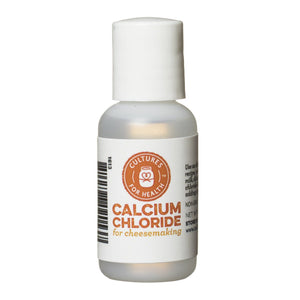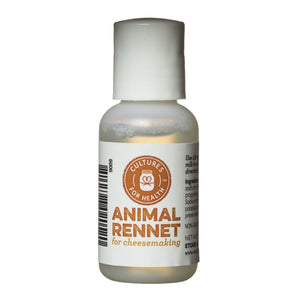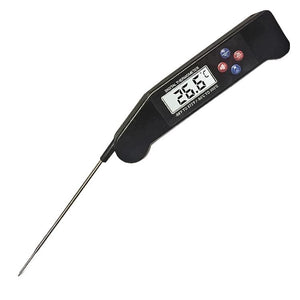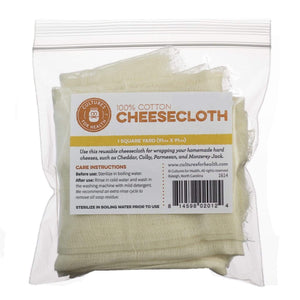
Flavorful, creamy, and firm, cheddar cheese can be used in a variety of ways: sliced for sandwiches, grated as a garnish for soups or salads, pared into curls to top a casserole, or just eaten in bite-size pieces with fruit or on its own.
This recipe will show you exactly how to make cheese - cheddar cheese that is. And click here to download our full cheese making recipe book, filled with tips, tricks and recipes to make amazing cheeses.
2 hours
1488 hours
20 Servings
INGREDIENTS AND EQUIPMENT AVAILABLE AT CULTURES FOR HEALTH
Mesophilic Direct-Set Starter Culture

Mesophilic Direct-Set Starter Culture
$19.99
From cheddar, Colby, and Monterey Jack to Feta, Chevre, and more, you'll enjoy the flavor and variety of homemade cheeses made using this starter culture.
Calcium Chloride

Liquid Animal Rennet

Liquid Animal Rennet
$12.99
High quality single strength animal rennet. This non-GMO animal rennet is preferred for aged cheese as it creates a more desirable flavor and aroma during the aging process. Each bottle contains enough rennet to set (12) 2-gallon batches of cheese.
Cheese Salt

Digital Thermometer

Digital Thermometer
$19.99
Temperature is extremely important when it comes to baking. Eliminate any guesswork with this instant-read digital thermometer so you can keep track of your dough temperature, ambient temperature!
*Requires 2 AAA batteries, not included
Cheesecloth

Cheesecloth
$7.99
A looser weave than our butter muslin, this 100% cotton cheesecloth is great for wrapping cheeses and draining whey from all sorts of cultured foods.
ESSENTIAL EQUIPMENT FOR CREATING YOUR OWN CHEESE:
- Mesophilic Cheddar Cheese Starter Culture
- Large pot
- Thermometer
- Long knife (curd knife; does not need to be sharp)
- Cheesecloth
- Cheese wax
- Cheese press
CORE INGREDIENTS FOR OUR HOMEMADE CHEDDAR CHEESE RECIPE:
- 2 gallons cow or goat milk (do not use UHT/UP milk)
- 1/8 tsp. calcium chloride diluted in 1/4 cup water (optional)
- Mesophilic culture (choose one):
- 1 packet direct-set mesophilic culture
- 1/8 tsp. bulk mesophilic culture
- Rennet, dissolved in 1/2 cup cool water (choose one):
- 1/2 tsp. liquid animal rennet or
- 1/4 tsp. double-strength liquid rennet or
- 1/4 tablet vegetable rennet
- 2 Tbsp. sea salt
THE ART OF MAKING CHEDDAR CHEESE: A STEP-BY-STEP GUIDE:
An often overlooked, but crucial aspect of making cheese, and especially cheddar cheese, is the quality of the ingredients. A good quality, full-fat milk can make all the difference in achieving the perfect texture and taste. Where possible, try to use milk straight from the farm for the best results.
- In a large pot, heat the milk to 85°F, stirring frequently. This is the first step in how to make cheese at home.
- As the milk is heating, add the calcium chloride, if using.
- When the milk gets to 85°F, add culture, stir in with an up-and-down motion, cover, and allow it to ferment for 1 hour. This is a key part of the process when making cheese.
- Stir to homogenize the milk, and slowly fold in the diluted rennet. Using an up-and-down motion with your spoon will ensure that the rennet works its way through all the milk, yielding the highest possible results.
- Next, it's important to remember that cheese making is an art. The curds need to be handled gently throughout the process. Over-stirring can cause the curds to break down too much, leading to a dry, crumbly cheese. This is where the saying "the secret is in the stirring" comes from. The technique of gentle and regular stirring is essential to maintain the proper consistency of the curds and to control the release of whey.
- Remove from heat source and allow the cheese to set for 1 hour, or until the whey begins to separate from the curd.
- Using the knife, carefully cut the curds into ¼-inch cubes and allow to set for 5 minutes. Do not stir.
- Most homemade cheese recipes, including our cheddar cheese recipe, involve heating the curds, some cheesemakers also suggest keeping the curds warm after cutting them. This additional step, known as "cooking the curds," helps to further expel whey from the curds and results in a firmer cheese.
- Over the next 30 minutes, slowly heat the curds to 100°F, stirring frequently. This is a key part of how to make cheddar cheese.
- Once the curds are at 100°F, maintain the temperature and continue stirring for the next 30 minutes.
- After 30 minutes,stop stirring and allow the curds tosettle to the bottom of the pot. This will take about 20 minutes.
- Pour the curds into a colander. Place the colander and curds back into the cheese pot andallow to drain for 15 minutes.
- Remove the colander from the pot and turn the curds out onto a cutting board. You should have a semi-solid mass that looks like jelly. Pour the whey out of the pot, cut the mass into five slices, and place back into the pot.Cover.
- Filla sink or basin with102°F water and place the pot and curds into it. Keeping the temperature of the curds right around100°F,turn the slices every 15 minutes for the next 2 hours. This is the cheddaring process and will give your cheese its unique flavor and deliciousness.
- After 2 hours, the curds will be shiny and very firm.Remove them from the pot andcut into ½-inch cubes.Place back in the pot, cover, and place in the sink filled with 102°F water.
- In 10 minutes,stir gently with your fingers or a wooden spoon. Repeat twice more.
- Remove the pot from the sink andadd salt.Stir gently once more.
- Line the cheese press with a piece of cheesecloth and carefully place the curds into the press.Wrap the cloth around the cheese andpress at 10 pounds of pressure for 15 minutes.
- Remove the cheese from the press,unwrap, andflip the cheese.Re-wrap using a fresh piece of cheesecloth, andpress at 40 pounds of pressure for 12 hours.
- Remove the cheese from the press, unwrap, andflip the cheese.Re-wrap using a fresh piece of cheesecloth, andpress at 50 pounds of pressure for 24 hours.
- Remove the cheese from the press andair-dry for 2 to 3 days, until smooth and dry to the touch.
-
Wax the cheese and age at 55° to 60°F for at least 60 days. (Click here forpractical methods for aging cheese.)
START YOUR JOURNEY IN HOMEMAKING CHEDDAR CHEESE TODAY!
You’ve probably felt that learning how to make your own cheese is hard but you’ve just done it! If you don’t already have your cheese starter culture, what are you doing? This recipe works perfectly with the starters that Cultures For Health has. We’ve got everything you need and more to start making your own cheese today including cheddar cheese starters, cheesecloth, and cheese salt!
If you’re ready to start your fermentation journey and start making your own cheddar cheese, click here to check out our amazing cheddar cheese starting kit now and our available cheese making kit! Click here to download our full cheese making recipe book to start making your cheddar cheese at home, filled with tips, tricks and recipes to make amazing homemade cheeses.
















